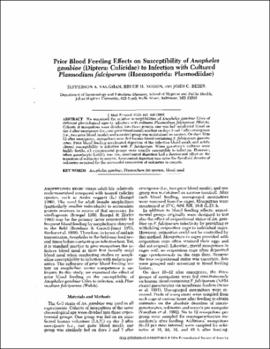| dc.contributor.author | Vaughan, Jefferson A. | |
| dc.contributor.author | Noden, Bruce H. | |
| dc.contributor.author | Beier, John C. | |
| dc.date.accessioned | 2022-04-12T13:30:21Z | |
| dc.date.available | 2022-04-12T13:30:21Z | |
| dc.date.issued | 1994 | |
| dc.identifier | oksd_noden_priorbloodfeedingeffects_1994 | |
| dc.identifier.citation | Vaughan, J. A., Noden, B. H., & Beier, J. C. (1994). Prior blood feeding effects on susceptibility of Anopheles gambiae (Diptera: Culicidae) to infection with cultured Plasmodium falciparum (Haemosporida: Plasmodiidae). Journal of Medical Entomology, 31(3), pp. 445-449. https://doi.org/10.1093/jmedent/31.3.445 | |
| dc.identifier.uri | https://hdl.handle.net/11244/335138 | |
| dc.description.abstract | We examined the relative susceptibilities of Anopheles gambiae Giles of different physiological ages to infection with cultured Plasmodium falciparum (Welch). Cohorts of mosquitoes were divided into three groups; one was fed uninfected blood on day 3 after emergence (i.e., one prior blood meal); another on days 3 and 7 after emergence (i.e., two prior blood meals); and a control group was maintained on sucrose. On days 10 to 12 after emergence, mosquitoes were fed human blood containing P. falciparum gametocytes. Prior blood feeding accelerated digestion of the infective blood meals and subtly altered susceptibility to infection with P. falciparum. When gametocyte cultures were highly fertile, all experimental groups were equally susceptible to infection. However, when gametocyte fertility was low, accelerated digestion had a detrimental effect on the transition of ookinetes to oocysts. Accelerated digestion may raise the threshold density of ookinetes required for the successful conversion of ookinetes to oocysts. | |
| dc.format | application/pdf | |
| dc.language | en_US | |
| dc.publisher | Oxford University Press (OUP) | |
| dc.relation.ispartof | Journal of Medical Entomology, 31 (3) | |
| dc.relation.uri | https://www.ncbi.nlm.nih.gov/pubmed/8057320 | |
| dc.rights | This material has been previously published. In the Oklahoma State University Library's institutional repository this version is made available through the open access principles and the terms of agreement/consent between the author(s) and the publisher. The permission policy on the use, reproduction or distribution of the material falls under fair use for educational, scholarship, and research purposes. Contact Digital Resources and Discovery Services at lib-dls@okstate.edu or 405-744-9161 for further information. | |
| dc.subject.mesh | Animals | |
| dc.subject.mesh | Anopheles | |
| dc.subject.mesh | Blood | |
| dc.subject.mesh | Eating | |
| dc.subject.mesh | Female | |
| dc.subject.mesh | Humans | |
| dc.subject.mesh | Insect Vectors | |
| dc.subject.mesh | Malaria, Falciparum | |
| dc.subject.mesh | Oogenesis | |
| dc.subject.mesh | Plasmodium falciparum | |
| dc.title | Prior blood feeding effects on susceptibility of Anopheles gambiae (Diptera: Culicidae) to infection with cultured Plasmodium falciparum (Haemosporida: Plasmodiidae) | |
| dc.date.updated | 2022-04-07T14:57:59Z | |
| osu.filename | oksd_noden_priorbloodfeedingeffects_1994.pdf | |
| dc.description.peerreview | Peer reviewed | |
| dc.identifier.doi | 10.1093/jmedent/31.3.445 | |
| dc.description.department | Entomology and Plant Pathology | |
| dc.type.genre | Article | |
| dc.type.material | Text | |
| dc.subject.keywords | Rare Diseases | |
| dc.subject.keywords | Malaria | |
| dc.subject.keywords | Vector-Borne Diseases | |
| dc.subject.keywords | Infectious Diseases | |
| dc.subject.keywords | 2.2 Factors relating to the physical environment | |
| dc.subject.keywords | Infection | |
| dc.subject.keywords | 06 Biological Sciences | |
| dc.subject.keywords | 11 Medical and Health Sciences | |
| dc.subject.keywords | Tropical Medicine | |
| dc.identifier.author | ScopusID: 7202772214 (Vaughan, JA) | |
| dc.identifier.author | ORCID: 0000-0002-0096-370X (Noden, BH) | |
| dc.identifier.author | ScopusID: 6601968347 (Noden, BH) | |
| dc.identifier.author | ScopusID: 7102003162 (Beier, JC) | |
